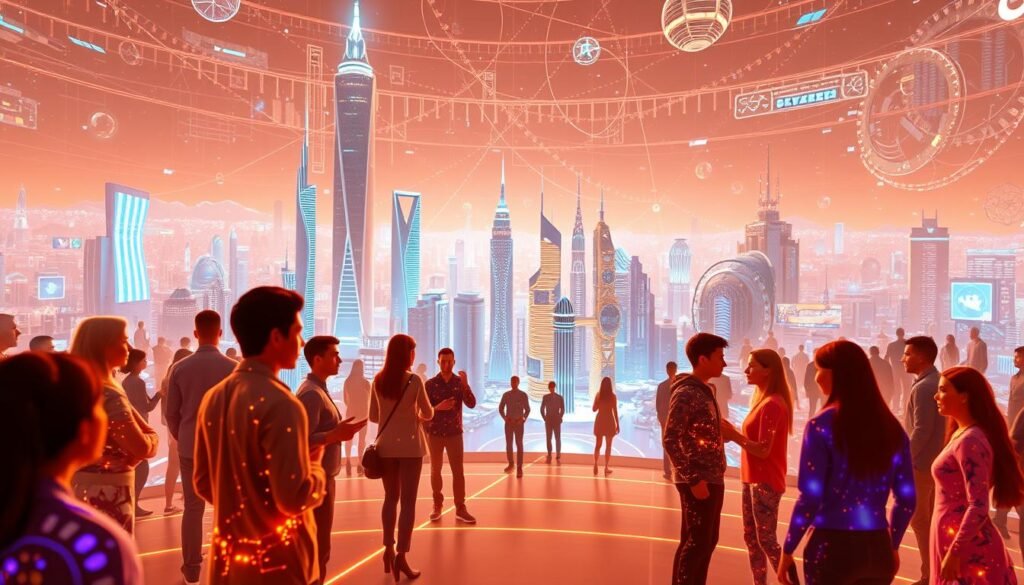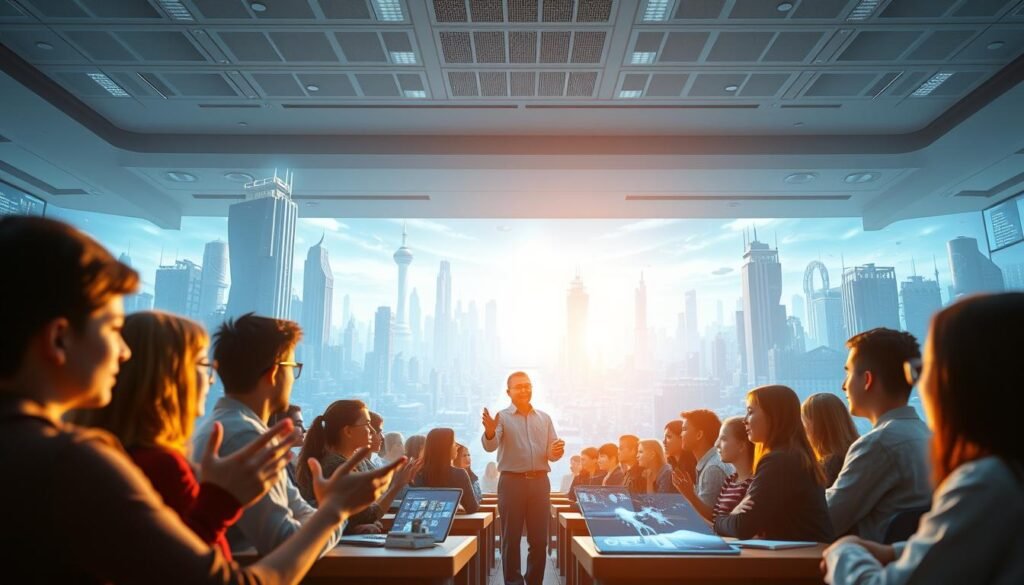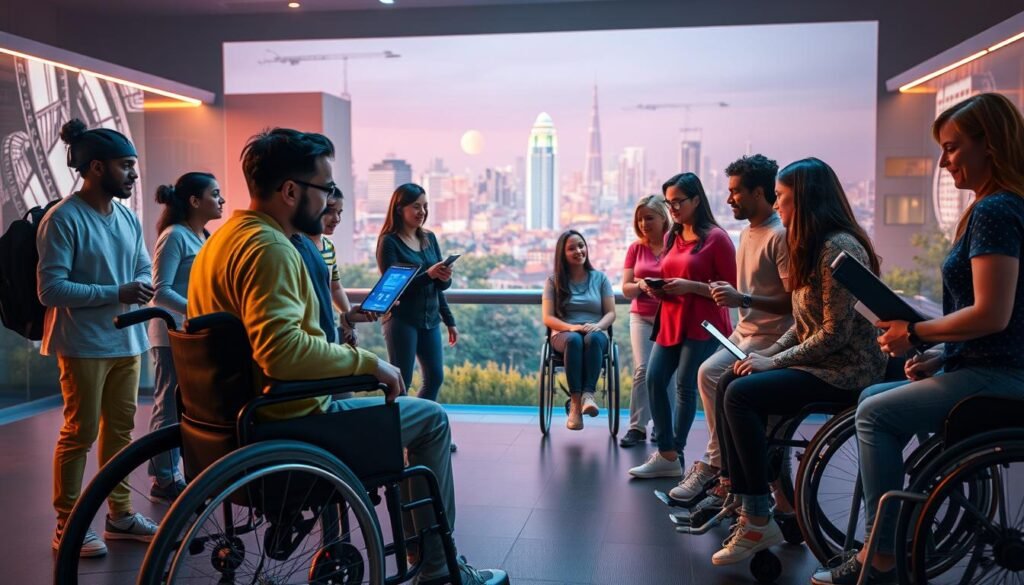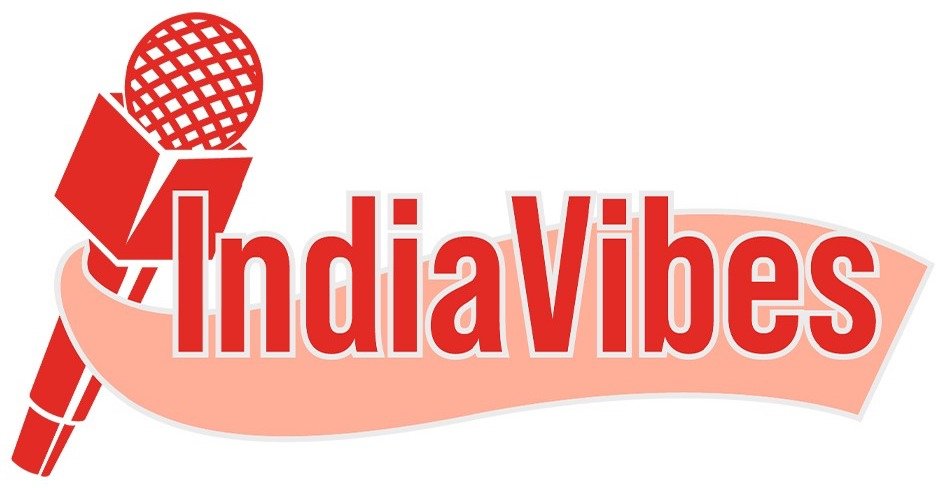The Metaverse impact on social interaction is growing rapidly, with over 1 billion users expected by 2026. This transformation is reshaping how we communicate and build relationships online. It’s making our digital interactions feel more real.
The Metaverse is more than just virtual reality. It’s a big change in how we use digital spaces. It lets us work together and connect with people all over the world. It’s making our social lives better with new ways to make friends and share experiences.
What is the Metaverse?
The Metaverse is changing how we think about virtual interactions. It’s a digital world that combines augmented reality (AR) and virtual reality (VR). Here, people can connect and share experiences in a lasting space.
Definition and Overview
The Metaverse is a big step forward in online interactions. It offers experiences that mix the real and digital worlds. This world helps people connect, be creative, and work together.
By understanding the components of Metaverse, we see how different technologies come together. They create lively communities and exciting experiences.
Key Components of the Metaverse
To really get the Metaverse, we need to look at its key parts. These include:
- Virtual Reality (VR): Makes environments that feel like real life.
- Augmented Reality (AR): Adds digital info to the real world for better interactions.
- Blockchain Technology: Keeps things secure, ensures ownership, and makes transactions clear.
- Digital Avatars: Let users show themselves in this shared world, making it personal.
Historical Context of Online Social Interaction
The need to connect with others has grown, leading to online social interaction. From simple chatrooms to today’s social media, we’ve come a long way. This journey shows how we got to the Metaverse we know today.
Evolution from Internet Chatrooms
Chatrooms were the first online spaces for socializing. They allowed text-based communication, setting the stage for future advancements. With feedback, chatrooms evolved, adding private messages and group chats. This changed how we interacted online, making connections possible that were once unthinkable.
Growth of Social Media Platforms
As technology improved, social media grew, changing how we share and connect. Sites like Facebook, Twitter, and Instagram made sharing lives easier. They helped build global communities and fostered new relationships, showing the power of digital communication.
| Chatroom Era | Social Media Era |
|---|---|
| Text-based interactions | Multimedia sharing (images, videos) |
| Simple user interfaces | User-friendly, dynamic interfaces |
| Limited user base | Global connectivity and massive user bases |
| Anonymous communication | Identity-based engagement |
The Role of Virtual Reality in Social Interactions
Virtual reality has changed how we connect and interact. It lets us dive into virtual worlds where we can talk and work together. These virtual spaces make our social interactions richer and more meaningful.
Immersive Experiences in Socializing
VR experiences feel real, making our interactions feel genuine. We can share moments and express feelings in ways online platforms can’t. This helps us build real connections and feel part of a community.
VR Applications and Platforms
Many VR apps are now used for socializing. Places like VRChat and AltspaceVR show how VR can bring people together. These apps let us chat in real-time, share moments, and work together. They open up new ways to connect across distances.
Enhancing Connectivity: The Metaverse’s Promise
The Metaverse offers a new way for people to connect. It lets folks from all walks of life meet in ways we never thought possible. Users can dive into virtual worlds, breaking down barriers that once kept us apart.
Bridging Gaps Across Distances
The metaverse is a bridge that connects us all. People can attend events, join conferences, and meet up without worrying about where they are. This opens doors to new friendships and connections, bringing people together who might not have met before.
Building Global Communities
In the Metaverse, we can build communities that span the globe. People can come together based on common interests, work goals, or causes they care about. These virtual spaces help us form lasting bonds and work on projects that make a difference worldwide.

Challenges to Authentic Social Interaction
The Metaverse offers new ways to connect, but it also raises big challenges. Privacy and security are major concerns. We need to build trust in this digital world.
Isolation is another big issue. The pull of virtual worlds can make us forget about real-life friends and family. It’s important to find a balance between online and offline life.
Issues of Privacy and Security
Privacy is a big worry in the Metaverse. Platforms collect a lot of personal data. It’s key to know how this data is used and if it’s safe.
Strong security measures are needed to keep users safe. Learning about these risks helps us make better choices online.
The Risk of Addiction and Isolation
The Metaverse can be very addictive. People might spend too much time online, losing touch with the real world. This can harm our mental health.
It’s easy to get caught up in virtual worlds and forget about loved ones. Finding a balance is key to staying healthy and connected.
| Aspect | Privacy Issues | Risk of Isolation |
|---|---|---|
| Data Collection | High levels of user data collected | Limited real-world interaction |
| User Trust | Questionable consent practices | Preference for virtual over physical connection |
| Security Measures | Need for robust privacy protocols | Increased reliance on virtual communities |
| Awareness | Importance of user education | Emphasis on maintaining balance |
Cultural Implications of the Metaverse
The Metaverse is changing how we see culture, with big effects on Indian society. Virtual spaces are changing old norms and practices. This change brings up both good and bad points for cultural identity.
Influence on Indian Society
The Metaverse is mixing Indian culture with global trends. Young people are seeing new ways to express themselves. They get to meet different views and question their own culture.
Cross-Cultural Interactions in Virtual Spaces
People from all over are meeting in the Metaverse. They share stories, art, and traditions. This helps everyone appreciate diversity more.
| Aspect | Impact on Indian Society | Cross-Cultural Interactions |
|---|---|---|
| Identity Exploration | Emerging new cultural identities | Understanding and appreciation of diverse cultures |
| Tradition vs. Modernity | Adapting traditions to modern contexts | Blending of cultural practices |
| Community Building | Creating virtual communities around shared interests | Encouraging global friendships |

The Impact of the Metaverse on Relationships
The Metaverse changes how we connect with others. It makes our relationships stronger and helps us form new ones. This digital world brings people together in ways we never thought possible.
Strengthening Existing Connections
The Metaverse lets us stay close to loved ones, no matter where they are. We can play games, have family time, or go to events together. This strengthens our bonds and creates lasting memories.
It shows how important it is to connect in a world filled with technology.
Forming New Types of Relationships
In the Metaverse, we meet people who share our interests. These new relationships in virtual spaces grow from online communities or projects. It changes how we see friendship and networking.
| Aspect | Traditional Interaction | Metaverse Interaction |
|---|---|---|
| Geographical Barriers | Limited by physical location | Global access to friends and like-minded individuals |
| Shared Experiences | In-person events | Virtual gatherings and activities |
| Emotional Engagement | Face-to-face communication | Immersive environments that enhance connection |
| Networking Opportunities | Local social events | International communities and collaborations |
Education and Social Interaction in the Metaverse
The Metaverse is changing education, bringing new ways to learn and interact. It offers virtual classrooms and learning spaces that are engaging and interactive. This new approach uses technology to improve how students learn and interact with each other.
Virtual Classrooms and Learning Environments
Virtual classrooms in the Metaverse have many tools and resources. They help students learn in different ways. Students can share knowledge and experiences in real-time, making learning more fun than usual.
This setup also breaks down barriers of distance. It lets students from anywhere get quality education. This makes education more inclusive and meets the needs of all learners.
Collaboration and Peer Interactions
In the Metaverse, students can work together better. They can do projects, discuss topics, and join in activities that feel real. This part of education in the Metaverse helps build strong relationships and a sense of community.
It also makes learning more active and engaging. Students are encouraged to participate fully, which is key for a good learning experience.

Economic Opportunities and Social Networking
The Metaverse is changing how we work, opening up new economic chances. It’s creating new jobs in areas like virtual events, digital architecture, and content creation. These fields are attracting people who want to try new things and be creative.
New Job Sectors in the Metaverse
This new world is welcoming people from all walks of life. You can find jobs like:
- Virtual Event Planners: They organize online events like conferences and concerts.
- Digital Architects: They design cool virtual spaces that people love to explore.
- Content Creators: They make stories and experiences that connect with people in virtual worlds.
- 3D Modelers: They create 3D objects that make virtual worlds feel real.
Networking Events and Professional Growth
The Metaverse is also great for making professional connections. It hosts virtual events where people can meet and work together, no matter where they are. These events are fun and easy to use, helping people grow their networks and find new opportunities. Some examples include:
- Industry-Specific Networking: Events focused on specific jobs, where people can share ideas and learn from each other.
- Collaborative Workshops: Hands-on sessions where people can share skills and come up with new ideas together.
- Career Fairs: Online places where companies and job seekers can meet, talk about jobs, and find the right fit.
Accessibility and Inclusivity in the Metaverse
The Metaverse is a chance to make things more accessible and inclusive for everyone. It lets people from all walks of life join in without any barriers. Virtual spaces are designed to make sure everyone can take part, no matter their abilities.
Overcoming Physical Barriers
Physical barriers can keep people from joining in. The Metaverse changes this by using virtual spaces. It uses technology to make experiences for everyone, like customizable avatars.
This focus on accessibility in Metaverse makes people feel more connected. It helps everyone feel like they belong.
Supporting Diverse Demographics
Inclusivity is key in the Metaverse. Developers work hard to meet the needs of all users. They add things like multilingual support and environments for people with disabilities.
By doing this, they create a place where everyone can feel welcome. This unity leads to deeper connections. Here’s a table showing how to support different needs:
| Strategy | Description | Benefits |
|---|---|---|
| Customizable Avatars | Allows users to create avatars representing their identity. | Fosters personal expression and connection. |
| Multilingual Options | Provides content in various languages. | Increases accessibility for non-English speakers. |
| Inclusive Design | Creates environments accommodating users with disabilities. | Enhances participation for all users. |
| Cultural Relevance | Offers content that resonates with different cultural backgrounds. | Strengthens community ties and engagement. |

Future Trends in Social Interaction
The world of social interaction is about to change a lot in the next ten years. New technologies will change how we connect with each other. We think these changes will make social experiences better.
Predictions for the Next Decade
Looking ahead, we see some big changes in social interactions:
- Increased personalization: New algorithms will learn what we like and how we interact. This will make our experiences more personal.
- Enhanced user agency: We’ll have more control over our online identities and where we interact.
- Seamless integration: Social platforms will blend together, making it easy to move between different parts of the Metaverse.
- New forms of communication: We’ll see new ways to talk, like holograms and mixed reality, changing how we communicate.
The Future of AI in Social Interactions
AI in the Metaverse could change social interactions a lot. As AI gets better, it will make social spaces even more interesting:
- Virtual companions: AI avatars will become common, giving us friends and support in the virtual world.
- Smarter content generation: AI will help create stories and experiences just for us, making interactions more real.
- Real-time feedback: Tools will analyze our interactions and suggest ways to improve our social experiences.
These changes will not only make our connections stronger but also change society. As we move into this new world, we need to use these technologies wisely. This will help create a better place for social interaction in the Metaverse.
Embracing the Metaverse for Better Social Connections
The Metaverse is changing how we connect with each other. It goes beyond old online platforms to offer real virtual experiences. This new world helps us connect better, no matter where we are.
We’ve seen how the Metaverse is changing our lives. It’s not just about new tech; it’s about how it affects our culture and society. We must use these tools wisely, keeping our privacy and connections strong.
Our future is bright if we use the Metaverse well. It can bring our digital and real worlds together. This way, we can build true friendships and have better social times. Let’s work together to make this future a reality.




